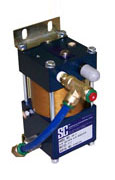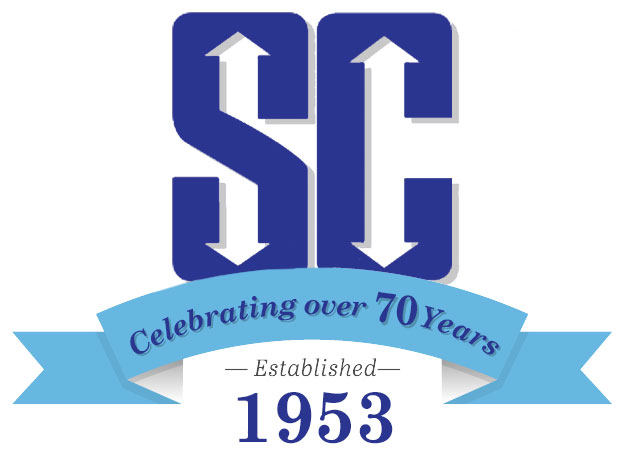

SC Hydraulic Engineering offers a complete selection of air boosters for almost any application. From economical compact single-acting two and four-to-one models to double-acting two and five-to-one models we can size a unit or system to fit your exact requirement.
The principle of the air booster works much the same as our liquid pumps in which a larger air drive piston is directly connected to a smaller pumping piston. The incoming air from the compressor drives the booster and also feeds the supply to the unit. Pressures can be boosted up to 680 psi on the single-acting AB-7 and as much as 850 psi on our double-acting ABD-5.
All SC air boosters are pre-lubricated at the factory and should not be used with inline air lubricators. Clean, dry air is very important as any grit, moisture, or foreign matter in the air supply can damage the high pressure components. A coalescing filter is recommended before the air supply and air drive inlet, which can be the same.
Typically, air boosters are used to build up pressures for static holding applications. Under normal, intermittent duty, the air cycling valve should be inspected and re-lubricated after 500,000 cycles. For continuous operation the booster should not be operated at more than 40 cycles per minute and should be inspected and re-lubricated every 150,000 cycles or 60 operating hours.
In addition SC Hydraulic Engineering offers four standard air booster systems, which include an air booster, air controls, pressure gauges, high pressure receiver tank., safety relief and high pressure regulator.
Custom booster systems are also available with multiple boosters, special tanks, custom skids, and more. In most cases a custom booster system can be designed, manufactured, tested and shipped in four weeks or less; usually in less time than our competition can ship a standard unit.
Contact us direct, or one of our qualified distributors, with your specific requirements and let us help you with any of your air booster applications.
Or better yet take a minute to read the glossary of terms below so you know the information we need, then fill out the online Air Booster Worksheet. Please make sure to fill out the form completely as all the information is important. We'll have an answer for you within a couple of hours with a selection of boosters, fill times if required, pricing, delivery time, and the name of your nearest distributor.
We figure you have better things to do with your time besides doing our job. For the best service in the industry, call SC Hydraulic Engineering.
Glossary of Terms
Glossary of Terms
Pressure from air/gas compressor available at the booster to drive the unit. If the pressure fluctuates, the lowest pressure available is used to calculate the output gas pressure. The Pa, and in some selections, along with the supply pressure will determine the maximum stall pressure of the booster.
Va (Air Drive Flow)
Volume of air/gas measured in SCFM (standard cubic feet per minute) available to drive the unit. The volume of air/gas determines the speed in which the booster will cycle and therefore the volume delivered from the outlet port. The volume of outlet gas also determines the speed in which a vessel is filled to a static pressure.
CPM (Air Drive Speed)
Cycles per minute when operating the booster, which is determined by the volume of drive air/gas available. The CPM is highest when starting to fill a vessel and decreases as the output pressure increases until reaching the static or stall pressure.
Ps (Air Supply Pressure)
Pressure of the air from the supply source. If the supply is from an air compressor or very large source, the Ps may be considered constant. If from a smaller source, typically bottles, the Ps will decrease as the supply is used. The decrease in supply will affect the static pressure output (in certain boosters) and the fill time or SCFM of the output.
Vs (Air Supply Volume)
Volume of the air available from the supply source. This is measured not by SCFM but by ACF (actual cubic feet) or water volume of the source. If the supply is from an air compressor or very large source, the Vs may be considered unlimited. The ACF of the supply determines how many fills to a certain static pressure can be made until the source is depleted.
Po (Air Outlet Stall Pressure)
Pressure of the air at the outlet. This can be stated as an output pressure at a certain SCFM or as the static output stall pressure when filling a vessel.
Vo (Air Outlet Flow)
The volume of air delivered at the outlet port measured in SCFM. This can be converted to ACFM if the temperature of the output air is known using the formula: ACFM = SCFM x 14.696 / (Pa + 14.696) x degrees F. / 530.
Two series available - choose from:




